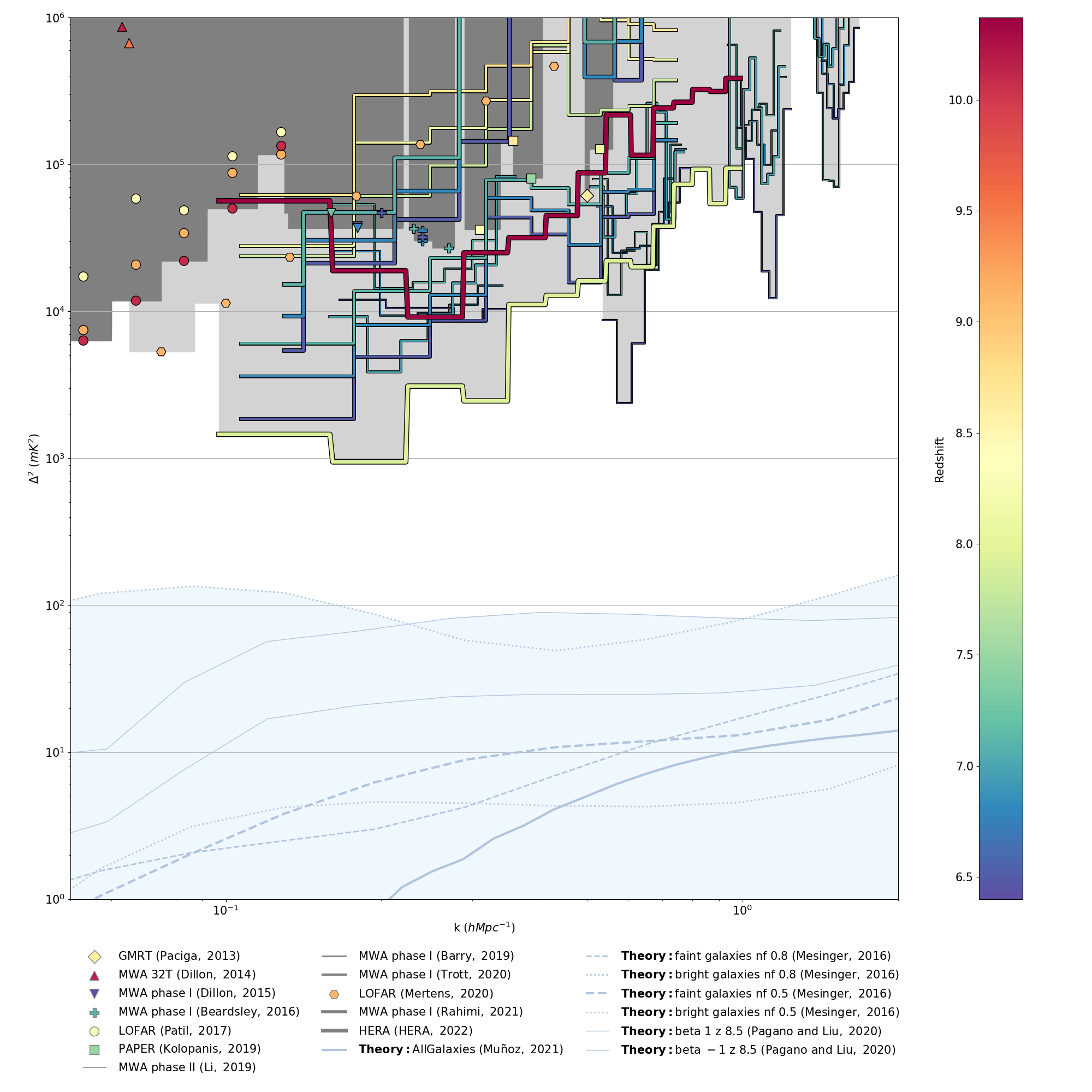eor_limits is a small utility for plotting EoR Limits.
The primary functionality is to plot published limits and simulations as a function of k and redshift. The data for the plots is included in human-readable yaml files in the data folder, so adding new data or theory lines is as simple as putting the data in a yaml file and placing it in the data directory.
We aim to continually update the repository to include all published limits in the field. The goal is to make it easier for experimentalists and theorists to add their own data or simulations and quickly compare on a 'standard' plot.
This code snippet is fully open source (BSD). Feel free to use the resulting plots in papers or presentations as you see fit.
We show a sample plot below, the appearence is highly customizable through keywords.
We welcome pull requests to add new data sets or simulations. We require that data and simulations come from peer-reviewed published papers. If you would like to add unpublished data or simulations to a plot, please fork this repository and add the data or simulations in your fork. If the data or simulations are subsequently published we welcome a pull request from your fork to add them to this repository.
We also welcome bug reports or feature requests, please file them as issues on the github repository.
Clone the repository using
git clone https://github.com/EoRImaging/eor_limits
For a simple user installation, change directories into the eor_limits folder and run pip install . (including the dot).
To install without dependencies, run pip install --no-deps . (including the dot).
Developers who would like to contribute to the code should follow the directions under Developer Installation below.
If you prefer to manage dependencies outside of pip (e.g. via conda), you will need to install the following dependencies.
- numpy
- matplotlib
- pyyaml
First, clone the repository as described above. In order to do development on the code, you will need several additional dependencies.
If you want pip to manage your dependencies, navigate into the pyuvdata directory and
run pip install .[dev] (note that python setup.py install does not work).
If you use anaconda or another package manager you might prefer to first install the dependencies listed in Dependencies along with the following developer specific dependencies:
- pytest
- pytest-cov
- coverage
- pre-commit
Or you can use the included environment.yaml file to create a new environment that will
contain all the dependencies required for testing and development (conda env create -f environment.yaml).
Then install without pip managing dependencies using pip install --no-deps . (including the dot).
To use pre-commit to prevent committing code that does not follow our style, you'll need to run pre-commit install in the top level eor_limits directory.
You can use the software either directly from the UNIX command line (pdf output), or from within a python notebook (inline figure).
After installation, call the plotting script as plot_eor_limits.py from the command line to make the default
plot (including all the papers in the data folder). There are a number of
options to customize the plot, use plot_eor_limits.py --help
to see the various options.
For example, plot_eor_limits.py --bold barry_2019 kolopanis_2019 li_2019 would bold the references to the papers published in 2019.
Alternatively, to make the plot within an interactive environment like a Jupyter notebook, run:
import eor_limits
eor_limits.make_plot()
and the plot should appear inline
To see the options type eor_limits.make_plot? in the environment. For example eor_limits.make_plot(bold_papers='barry_2019 kolopanis_2019 li_2019') would bold the references to the papers published in 2019.
